|
A NEWSLETTER FROM THE SALT SPRING ISLAND FARMERS' INSTITUTE This is the Farmers' Institute newsletter for January. These happy buddies in the picture
|
|
This is the Farmers' Institute newsletter for January. These happy buddies in the picture are thinking about spring while everyone else is huddled away from the rain, ordering seeds and planning their garden.
Please FOLLOW THE BLUE LINKS TO WEBSITES OR VIDEOS. Below is a handy content list. |
Contents
▪ Farm Taxation and The Incorporation Study...............................Conrad Pilon
▪ Events, Clubs, Updates
▪ New Ground Water Legislation............................................Julie Ann Ishikawa
▪ The Compost Pile.................................................................Jokes For Everyone
▪ The Apple Core.................................................................................Conrad Pilon
▪ The Morton B. Stratton Manuscript Cont'd...........................Usha Reutenbach
|
SSI Farmers’ Institute AGM Meeting
Tues. 16 Feb 2016 7:30 pm
Upstairs Meeting Room
Guest Speaker- AGM Guest Speaker......DAVID ASTILL....retired educator, farmer, musician and raconteur. Dave is the president of the Salt Spring Abattoir Society. He will update us on recent operational changes at the community Abattoir. The Abattoir is undergoing major improvements to allow for processing beef and pork and Dave will update us on these exciting changes as well. We look forward to his progress report on this vital component of the agricultural community.
Please support your Institute and Directors by attending this meeting. |
Salt Spring Island's 21st Annual Seedy Saturday
This year's theme is "Breakfast in Beds"
February 12th, 13th, 14th, 2016.
Farmers' Institute 351 Rainbow Rd.
Salt Spring Island, BC
Friday Movie Night ($10 suggested donation)
7-9pm: "Open Sesame - The Story of Seeds" documentary film screening.
Seedy Saturday ($5 suggested donation)
10am-3pm: Seedy Saturday with vendors, pancake breakfast, free workshops, seed exchange, and kids activities
Sunday Workshops ($25 pre-registration includes lunch)
10:00-11am: Growing and Eating Pulses with Dan Jason
11:00-12:00pm Dealing with Drought - A Panel Discussion
12:00-1:00pm Catered Lunch
1:00-2:30pm: Resilient Gardening with Linda Gilkeson
Break out of your seed-coats and come celebrate a communal defrosting and re-ignition of our passions, penchants, and instincts for plant protection
Contact: Kaleigh Barton and Ben Corno 250-537-9600 or ssiseedysaturday@gmail.com |
Farm Taxation and the Incorporation Study Preliminary Report
BY Conrad Pilon
The Board of Directors of the Salt Spring Island Farmers’ Institute continues to monitor the progress of the Incorporation Study with particular attention to the real potential for tax increases to island farms. We outlined our concerns to the Islands Trust during the initial phase of the Incorporation Study in 2013.
Briefly, in August, 2013, the Salt Spring Island Agricultural Advisory Planning Commission, the Salt Spring Island Farmland Trust Society and the Salt Spring Island Farmers’ Institute reviewed a letter from the District of West Kelowna Agricultural Advisory Committee (Property Assessment Rates on Farm Improvements) which linked incorporation to a rise in property assessment rates on farm improvements such as houses and outbuildings. Incorporation resulted in an average increase of property taxes of 17.5% and an escalation of farm property taxes in the ALR (Agricultural Land Reserve) up to 240%.
Section 9 of the Salt Spring Island Incorporation Study Preliminary Report (released October 30th, 2015) recognizes that farm properties are unique, “as various different property tax exemptions apply to farm land, farm dwellings, and other farm improvements, depending on municipal status” and that “farm dwellings and improvements typically experience higher tax rates after incorporation”.
The Board of Directors of the Farmers’ Institute understands that the Provincial Government has the ability to enforce a limit on municipal taxes that would apply to farm property and not increase as a result of incorporation. However, the Farmers’ Institute is not assured that farmers on this island are fully aware of the potential tax implications of incorporation nor of the mechanisms that would have to be in place for such limitations to be put into effect.
In late November 2015, The Farmers’ Institute wrote again to the Incorporation Study Committee and the Islands Trust asserting that farming remains a vital and productive part of the local economy of Salt Spring Island and that the issue of potential farm taxation increase as a result of incorporation is of major concern to us.
Finally, to be clear, the Salt Spring Island Farmers’ Institute is and will remain impartial to the Incorporation Study being undertaken by the Islands Trust. The study should provide islanders with an objective assessment on the best form of governance to deliver local services to our community. Members of the Farmers’ Institute, the agricultural community and island residents will assess the findings and will consider the merits of the recommendations based on a variety of community and individual priorities and preferences. The Farmers’ Institute has requested that the Final Report of the Incorporation Study clarify any assumptions about tax increases on farms, clearly outline how exemptions for properties with farm status can be negotiated and how they will be communicated. |
THE SSI FARMLAND TRUST SOCIETY
ACREAGE STILL AVAILABLE
The Farmland Trust still has ACREAGE AVAILABLE FOR LONG TERM RENTAL at Burgoyne Valley Community Farm 2232 Fulford-Ganges Road.
We are accepting responses to our Request For Proposals (RFP) for these three parcels.
.
For more information and to submit proposals:
Salt Spring Island Farmland Trust Society
107 Castle Cross Rd,
Salt Spring Island, BC V8K 2G1
email: ssifarmlandtrust@shaw.ca
250 537 5302
www.ssifarmlandtrust.org
Please review the documents for:
1) Request for Proposals (RFP)
2) Memorandum or Agreement
3) Policies
4) Soil Analysis Report
GARDEN PLOTS
GET ON THE WAITING LIST
(20’ x 50’) - $40 per year.
For info see www.ssifarmlandtrust.org
Review: Shaw Family Gardens Handbook
for rules and application form.
Email: ssifarmlandtrust@shaw.ca
or 250-537-5302
Clubs & Updates of Interest
POULTRY CLUB
by Mike Hogan |
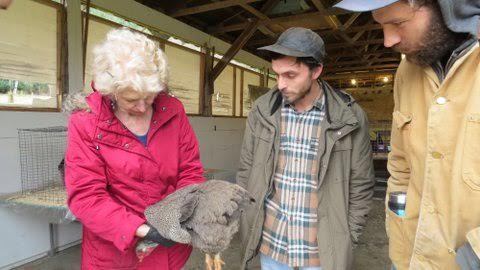 Emily Robertson - How to hold a chicken | | 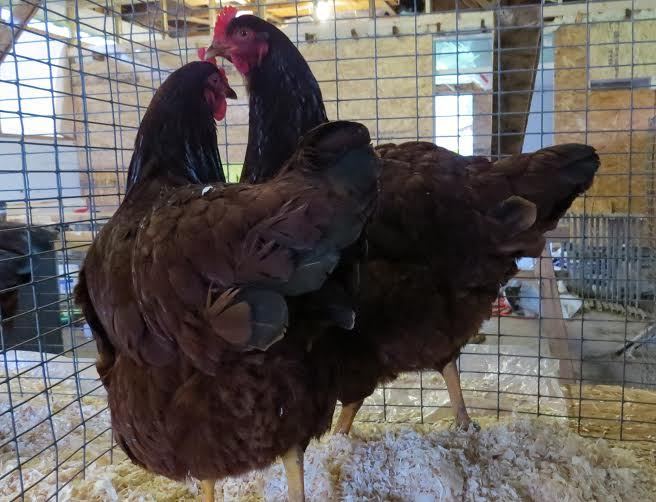 John Bishop's Rhode Island Reds |
|
The "Healthy Laying Chickens" workshop was attended by 50 people on January 30 held by the Salt Spring Poultry Club. Anne Macey started the day with a presentation on organic chicken production. The rest of the day was with Emily Robertson of True North Heritage Hatchery in Langley, she spoke about many aspects of raising healthy and productive layers. She gave great information about growing your own forage with a high but digestible protein content. She showed pictures of her own Light Sussex chickens in dense vegetation that sprang up from seed last spring. In the hands on part of the day she made chicken handling, weighing and checking for external parasites look easy. The poultry club plans on ordering some of the recommended forage mix seed mixes and will make these available to club members.
The next Club meeting is at 1 pm on Thursday Feb 18 at the Farmers' Institute. Subject matter is how and why to weigh a chicken, and how to apply a non-toxic treatment for mites and lice. New members of any experience level are always welcome. It is time for members to update their memberships with the $10 yearly member fee We are going to be doing some upgrading of our email discussion list and website and only paid members will have access to participate in the discussions. |
SALT SPRING ISLAND SPINNERS AND WEAVERS GUILD
on vacation |
ABATTOIR SOCIETY
Update
The abattoir is currently closed for renovations until the end of February. During the closure we will be literally raising the roof. This is needed so that we can begin to process beef and hogs in the coming year. Raising the roof is only part of the improvements being undertaken. Pens are being rebuilt and reinforced, the kill floor area will be expanded and a much stronger kill box installed. If all goes well we should be open once more in March.
We are currently investigating purchase of a second hand hog scalder/tumbler unit. We have had numerous inquiries this last year regarding swine processing. With some creative financing the service may be available early in the spring.
2015 was a banner year for the abattoir. We have seen record numbers of high quality birds come through our facility. Our staff have participated in a variety of training programs. 2016 promises to be even more encouraging as we expand the service provided. Thanks so much to all our local farmers that have supported us this year. |
SALT SPRING ISLAND BEE KEEPERS WILL BEE BACK |
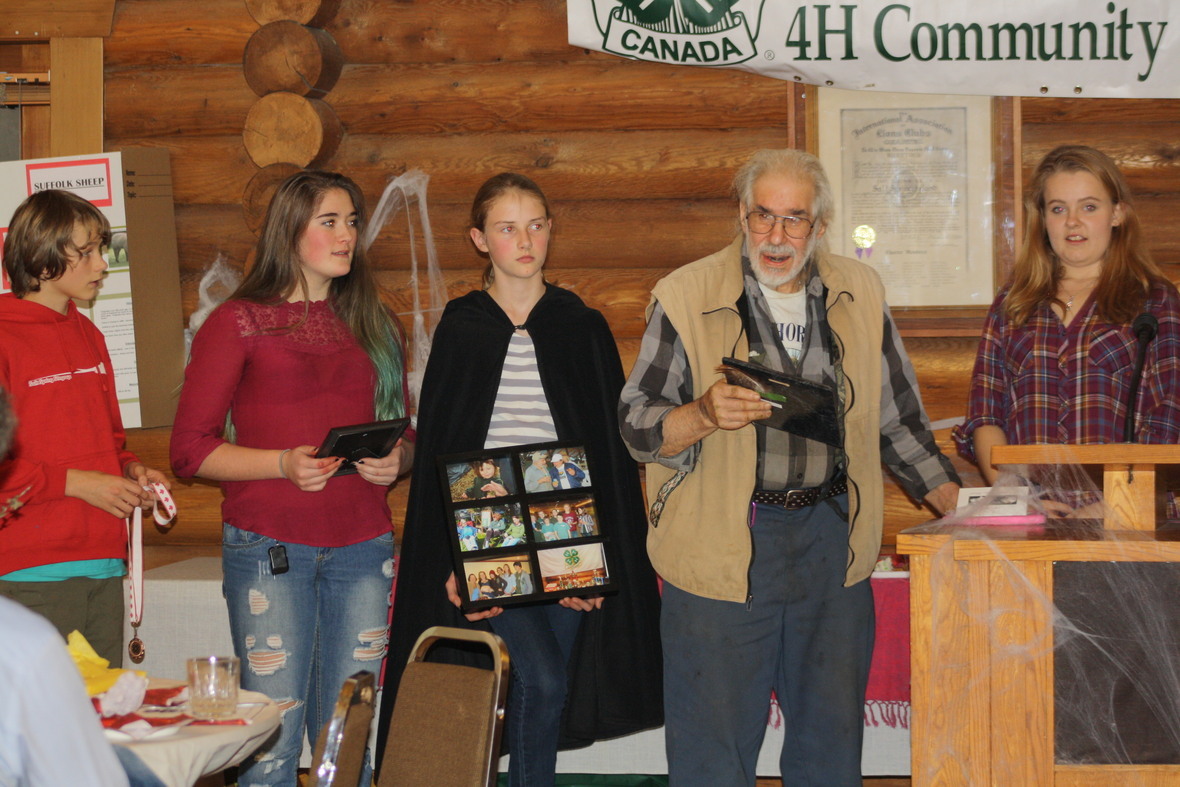 Art Falardeau "The Loose Cannon" |
SALT SPRING ISLAND 4H COMMUNITY CLUB
by Loretta Rithaler
The Salt Spring Island 4H Community Club approached its conclusion of the achievement year with as much gusto as they did the rest of their project work.
Members submitted their record books after a marathon day at their leader’s home where they worked together to put together the finishing touches on the final requirement for Achievement in their project work. They were submitted for marking by project leaders, with great results and positive comments on jobs well done.
As we entered November, we recognized National 4H Month by first holding our Club’s Annual General Meeting where our new officers were elected. Welcome aboard new Executive!
Saturday, November 7th was the District Awards Night in Saanich. This evening is hosted by the South Malahat District, in recognition of member achievement at the District Level. Anna made an oral presentation of our Club year (as Helena was unable to attend) and several of our members were recognized for their achievement as follows:
District Judging Field Day
- 3rd Place Senior Judging – District Judging Field Day (Anna)
- 4th Place Junior Judging (Liam)
- 6th Place Junior Judging (Quinn)
- 8th Place Junior Judging (William)
District Public Speaking
- 3rd Place Junior Public Speaking – District Public Speaking (William)
10-Year Member Pin
- Anna
Our focus then turned to preparations for our own Club Annual Banquet and Awards Ceremony on November 14th. This annual event where Members, sponsors and community supports are recognized for their fabulous project achievements and contributions toward our club:
Trophies were awarded for:
Sheep Showmanship, Rabbit Showmanship (Junior and Senior), Best Rabbit, Photography Achievement, Best Attendance, Sportsmanship, Leadership, Participation, Record Books, Junior and Public Speaking and several awards, all in recognition accomplishments by the members in their project work and in Club participation. Well done everyone! You have all had a super year.
There were several invited guests, including, but not limited to:
- grandmas and grandpas
- Judges (from the Saltspring Photography club)
- Judges (Public speaking)
- Sponsors (Country Grocer, Foxglove Farm and Garden, Slegg Lumber, Big Bear Services, Thomas Brainerd Tree Services)
- South Salt Spring Island Women’s Institute (Bev Cartwright and Angela Thomas)
Unfortunately, some were unable to attend due to illness, but we were delighted to see some familiar faces, including representatives from the South Salt Spring Island Women’s Institute (Angela Thomas and Bev Cartwright), Foxglove Farm and Garden (Chris Schmah) and Slegg Lumber (Mark Rithaler) . Without support of these businesses and long-established community partnerships, we could not continue to offer these valuable programs to the youth of our community . We are very grateful for the ongoing support and are delighted you could join us.
A very special part of our evening’s celebrations was a presentation was made to our dear friend, Arthur Falardeau, our “Loose Cannon”, who retired this year. We were honored to have Art and his son, Bud, present at this event, giving our Club the opportunity to show thanks and appreciation for Art’s support and dedication to our 4H Community Club. His efforts, generous spirit and hard work with our members, and encouragement of their 4H work will always be cherished and recalled with fondness.
Art was presented with a plaque and photograph display, celebrating a few highlights of his time spent with our Club at various 4H Club and community events. Once again, thank you so very much, Art for sharing your time and knowledge with us. Please come and visit often – we look forward to seeing you!
The Club members took great pride in assisting the Salt Spring Island Lion’s Club on December 6th, by serving the annual Seniors Christmas Luncheon to approximately 150 appreciative seniors from our community. This has become a staple in our 4H Calendar – it’s great fun and fabulous to see all those smiling faces enjoying a great turkey dinner prepared and provided by the hardworking Lion’s Club. A really great way to get in the Christmas spirit. Thank you very much for this opportunity!
Then came a short, but very well deserved break before commencing planning for the 2016 4H Year.
January 2016 has us off and running…..
Our Club Leader attended the Alberta 4H Leader Conference as the British Columbia Delegate, proudly representing our little island, on behalf of the Provincial 4H Program by carrying the provincial flag in the opening ceremonies of this annual event, attended by delegates from Alberta, Ontario and Saskatchewan. Our Club contributed to the Silent Auction table, which generated funds to support 4H programming.
January 24th was our first club meeting – focusing on Registration for the coming year.
We are delighted to report that we have 4 new Cloverbuds (ages 6-8 years). This group is being led by Anna, our most senior member, by creating a Junior Leadership Project, specifically for this purpose. Anna will have a volunteer helper, Jaylene, who will be assisting with this group. We also have one new Poultry project member.
As a result our club will be offering the following projects this year:
▪ Poultry
▪ Rabbit/Cavy
▪ Sheep
▪ Photography
▪ Self-Determined (possibly a Swine Project)
▪ And of course, we welcome back the CLOVERBUDS!
If you have friends, family or young people who may be interested in our program, or who are seeking an opportunity to volunteer by sharing knowledge or skills with us, please contact Loretta at lrithaler@telus.net. We would be happy to hear from you!
February will begin preparations for our Program skills, including one that 4H has become well known for: Public Speaking.
Looking forward to a busy and exciting year ahead, |
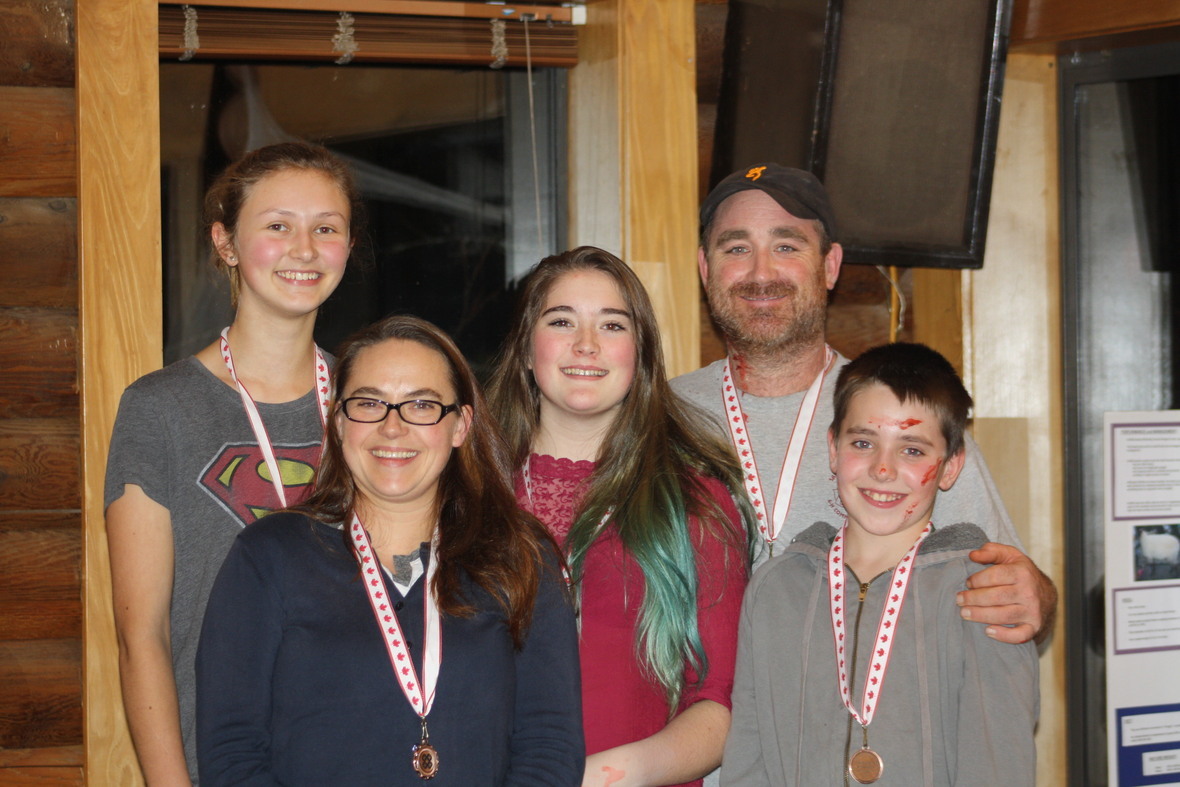 Happy at the Banquet | | 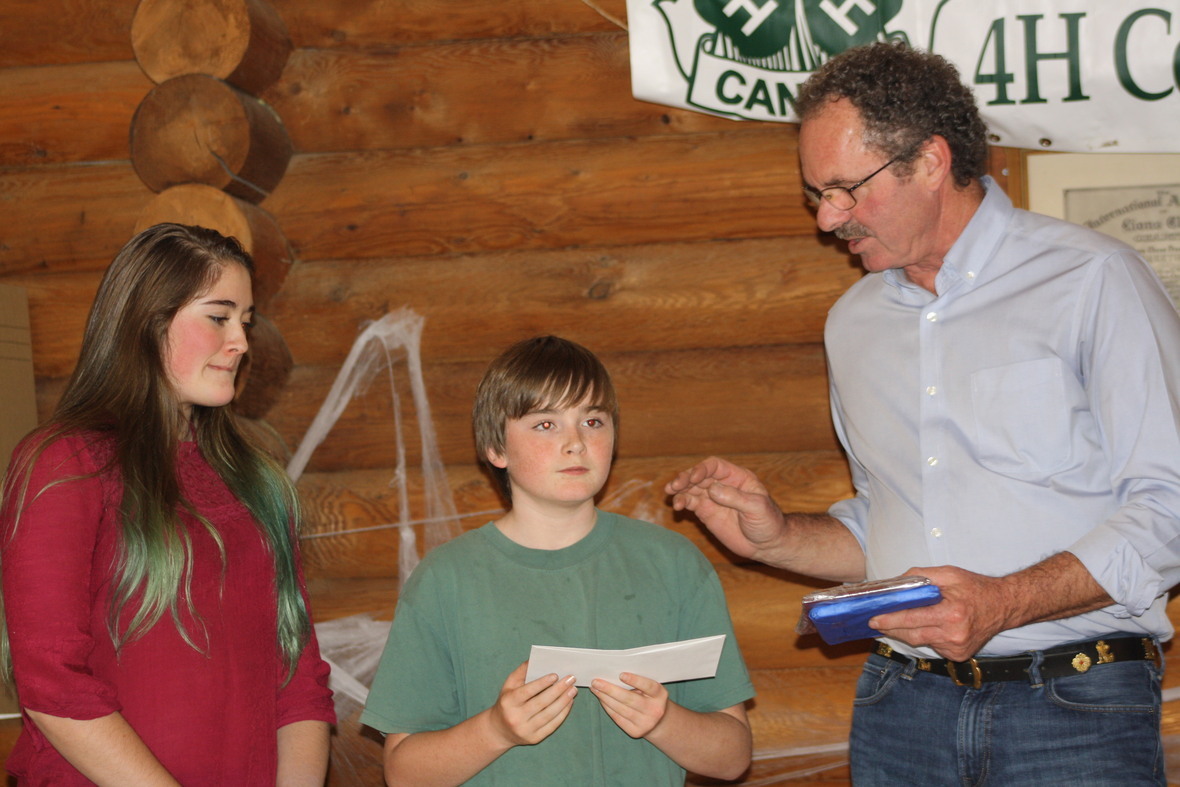 Helen,Liam & Chris at the 4H Banquet |
|
 Liam at 4H Banquet | |  SSI Women's Institute |
|
New Groundwater Legislation Ensures British Columbia’s Water Remains Healthy and Secure
By Julie Ann Ishikawa |
In 2009, the Government of British Columbia embarked upon a process to modernize its water legislation. After more than four years of public engagement and policy development, Bill 18, theWater Sustainability Act (WSA), received Royal Assent on May 29, 2014.
The WSA replaces the 106-year-old Water Act. However, the existing Water Act remains in effect until the regulations supporting the new legislation are complete and brought into force, which is expected to occur in 2016.
The new legislation introduces significant changes to how BC’s water is managed. In particular, the new Act recognizes that groundwater and surface water are interconnected and that both of these sources must be managed under the same regulatory regime. Under the WSA, groundwater use will be integrated into the water-licensing system, similarly to how surface water is managed now. Regulating groundwater use will increase the certainty of the groundwater supply for existing users and the environment, especially in areas of intensive water use. It will also provide clarity around legal access to groundwater for the people and businesses that rely on it.
The Regulations under the new act will also address several other aspects of water management such as environmental flow needs (EFN), water fees and rentals, and dam safety. These topics, however, fall outside the scope of this article.
Groundwater licensing
For the first time in BC’s history, all non-domestic groundwater users will require water licences and will obtain water rights. Non-domestic groundwater users, including those that use groundwater for commercial, industrial and irrigation purposes as well as municipal water works, will be included in the licensing system.
A three-year transition period is being proposed, to allow existing groundwater users to secure priority dates based on their historic dates of first use. After the transition period, all applicants will be treated as new users and will receive a new priority date, usually based on their date of application. To encourage users to apply early, the BC government proposes to waive application fees during the first year of the transition period. However, all transitioning non-domestic groundwater users will still be subject to annual water rentals that are calculated from the date the WSA is brought into force.
Under the WSA, each new groundwater user will have to demonstrate that sufficient water is available before being granted a licence. Generally, the statutory decision maker can require an applicant for a new groundwater licence—especially for larger proposed withdrawals; for example, greater than 10 m3/day—to submit a technical assessment report signed off by a registered professional (P.Eng., P.Geo., or limited licensee) with competency in the field of hydrogeology to support their application. For an application to be successful, the technical assessment would need to demonstrate that sufficient water is available to meet the needs of the intended use, and that the requested water withdrawal will not cause undue harm to other water users or the environmental flow needs of hydraulically connected streams.
First-in-time, first-in-right
The WSA will maintain a central principle of the existing Water Act. The first-in-time; first-in-right (FITFIR) system dictates that water rights be administered according to the date of precedence of the licence. Under FITFIR, senior licensees—those with the earliest priority dates—enjoy precedence over junior licensees, regardless of the purpose for which the water is used. During times of water scarcity, senior licensees are entitled to use their full allocation of water, even if this means junior licensees cannot use any of their licensed allocation.
However, the Water Sustainability Act recognizes three modifications to FITFIR:
1. During times of water scarcity, those who use stream water and groundwater for domestic purposes are allowed to divert water for “essential household uses”—established as 250 litres per day for each private dwelling.
2. If one or more streams in an area have fallen, or are at risk of falling, below their critical environmental flow thresholds, the BC minister of environment may make a temporary order declaring a significant water shortage. The critical environmental flow threshold required to prevent significant or irreversible harm to the aquatic ecosystem takes precedence over licensed water uses of the stream and any hydraulically connected aquifer. Water in excess of this minimum flow can be used by licensed water users according to their precedence in the FITFIR system.
3. Under a Fish Population Protection Order, the BC minister of environment may order any licensee, regardless of priority date, to temporarily reduce or stop water use in order to protect a population of fish.
During the transitioning of existing groundwater users under the new legislation, applicants must provide evidence to establish their date of first use. This is particularly important in areas where an aquifer is known to be stressed and in instances where groundwater withdrawals are considered hydraulically connected to surface water sources that have existing water licences.
Hydraulic connectivity
The WSA recognizes the hydraulic connection between groundwater and surface water, particularly in shallow sand and gravel aquifers where groundwater withdrawals directly affect availability of stream water for other users and for aquatic ecosystems.
The WSA requires that statutory decision-makers consider the environmental flow needs of a stream when reviewing an application for the use of water from an aquifer that is considered likely to be hydraulically connected to the stream. It also stipulates that decision-makers establish precedence of water use between all hydraulically connected surface water and groundwater users.
In contrast, under the existing Water Act, licensees holding a water right to a particular surface water source might face restrictions during times of water shortage according to their date of precedence, while more junior, unregulated users of hydraulically connected groundwater currently remain able to continue pumping without consequence, regardless of when they first installed their wells. In addition, in the past, when surface water licences have been denied to protect a stream considered to be fully allocated, instances have occurred where wells have been installed adjacent to the stream as an alternate water source.
The WSA establishes equity between hydraulically connected stream water and groundwater users and both types of water users will be subject to restrictions in times of scarcity.
Changes to the Groundwater Protection Regulation (GWPR)
The Groundwater Protection Regulation, which sets out standards to safeguard groundwater and ensures activities related to wells and groundwater are undertaken in an environmentally safe manner, is also being updated under the WSA. The revised regulation will incorporate most existing groundwater-protection policies, as well as introduce new policies. The new policies are designed:
• To improve well-construction and maintenance standards;
• To recognize the types of professionals certified to drill wells and install well pumps in BC;
• To bring flowing artesian wells under regulatory control, and;
• To require the submission of well records for some types of wells.
The updated legislation will also regulate recharge wells, which have become increasingly popular in many municipalities as a means of dealing with urban run-off, but pose a risk of contaminating underlying aquifers.
Next Steps
Development of regulations and policy is currently underway to enable the WSA to be brought into force. However, additional regulation and policy development will be required to fully implement all provisions enabled under the new legislation. Future work includes regulations that address, for example, licensing domestic wells in specific geographic areas, and policies that enable overdrawn aquifers to be closed. Developing these policies will take time.
For now, however, transitioning the approximately 20,000 existing, non-domestic groundwater users into the licensing system remains the priority. The BC Ministry of Environment is currently hiring and training new staff to deal with the expected workload. The existing e-licensing system is undergoing enhancements to incorporate groundwater licensing. In addition, the provincial water well data base (WELLS) and the provincial aquifer spatial layers are being enhanced to make them more relevant for water management decision making.
The government also recognizes that better understanding of the province’s aquifers is required to manage available water resources effectively and sustainably. It has initiated investigations to map and study aquifers across the province, particularly in areas of heavy water use and known water shortages. The investigations currently underway include estimating aquifer water budgets, and determining groundwater–surface water interactions, hydraulic connectivity, and the effects of groundwater withdrawals on environmental flow needs.
Conclusion
Water is our most precious resource. The WSA will strengthen provincial water management in the face of growing demands for water in a changing climate. The new legislation will help to ensure sustainable management of fresh, clean surface and groundwater in BC—to meet our needs today and through generations to come.
More information on the Water Sustainability Act and its implementation is available at:.
The author, Julie Ann Ishikawa, is a hydrogeologist with BC Ministry of Environment. She lives on Salt Spring Island with her husband and family, and works in the Victoria MOE office. She is a volunteer member of the Salt Spring Island Watershed Protection Authority's Technical Working Group |
THE COMPOST PILE
Unwritten rules of gardening .
The best way to garden is to put on a wide brimmed straw hat and some old clothes. And with a hoe in one hand and a cold drink in the other, tell somebody else where to dig.
Compost is best aged a little like a fine wine. I mean, would you prefer to drink a nice 97, or something that was made last Thursday.
When weeding, the best way to make sure you are removing a weed and not a valuable plant is to pull on it. If it comes out of the ground easily, it is a valuable plant.
A weed is a plant that has mastered every survival skill except for learning how to grow in rows.
Spring does not arrive until the ice is out of the compost heap.
Winter does not arrive until the ice is IN the compost. Until then, all bets are off.
Any self respecting rock will break at least one shovel before accepting its new home.
A good compost pile should get hot enough to poach an egg, but not so hot it would cook a lobster.
Gardening requires a lot of water most of it in the form of perspiration. |
The Apple Core
By Conrad Pilon
Why Graft?
Or almost everything you wanted to know about grafting
but were afraid to ask.
On Saturday March 26th, I am planning a ‘grafting’ session at my small farm, Oscar’s Meadow, on Whims Road. For the last fifteen years or so I have been collecting apple and pear scions from various island orchards (Bond Farm, Bob & Judy Weeden’s, George Laundry’s, Larry Appleby’s…) and grafting them to various rootstock I obtain from the BC Fruit Testers Association. These ‘new’ fruit trees end up back in orchards all over the Salt Spring Island while others grow in the Shaw Community Gardens at the Burgoyne Valley Community Farm or are sold at the Salt Spring Island Apple Festival in September.
My able assistant Igor (a.k.a. Mike Lakin) and I would like to invite Farmers’ Institute members to a hands-on grafting basics session. We will, as best we can, demonstrate the ‘whip and tongue’ and ‘cleft’ grafting methods, safety measures, potting soil preparation, scion collection, rootstock selection, and encourage participants to do all the heavy work, such as carting soil and transferring the pots! And we will definitely answer that scholarly laden question: Why Graft? Fortunately this year, I have only twenty rootstocks, so the session will not be too ponderous.
The session should give members enough of the nuts and bolts to loose their fear of grafting. Space is limited, so if you are interested please contact me via e-mail at cgpilon@telus.net. No need to bring tools, unless you already have a really good grafting knife. If the weather does not cooperate, this session might be re-scheduled. I will notify the participants if this is the case.
One final detail, if you have an apple variety you particularly keen on and would like to graft it to new rootstsock please get in touch with me a.s.a.p. |
The Morton B. Stratton Manuscript - Cont'd
By Usha Reutenbach
The Morton B. Stratton Manuscript PART 3
In the last Cultivated Farmer newsletter, you may have read my article “The Morton B. Stratton Manuscript - Cont'd"
(If your memory comes up blank, it can be refreshed by going to: https://madmimi.com/s/b5eed6 and scrolling down to the bottom of that newsletter - it was about the manuscript having been in the Salt Spring Island Archives since 1993.)
That article was continued from an informative news item, “The Morton Stratton Manuscript”, written by Conrad Pilon.
(To re-read Conrad’s piece: https://madmimi.com/s/382076 and find the third article; it is about the Directors deciding to celebrate 120 years of serving the island’s farmers by publishing the manuscript as a book.)
Following in the Footnotes of Morton B. Stratton
Morton B. Stratton blessed our small community of Salt Spring Island with historical research he did in the early 1990’s, exploring the History of Agriculture on Salt Spring Island. He and his wife Biz had come here to retire in 1970. I first came in 1981.
As a volunteer researcher for our local archives, I discovered Morton Stratton’s unpublished manuscript in 1996; it provided the backbone of all the research I have done since for the Salt Spring Island Farmers Institute. His text reads easily, yet is meticulously evidence-based. Why had it not been published?
Why did the Manuscript languish unpublished?
The typescript manuscript was in two parts. Part One, 1859-1885, completed on August 15, 1991 and Part Two, completed October 1993. Part Two was intact with its pages of 93 footnotes following the text. Part One was liberally scattered with indications of closer to 200 footnotes - but no footnote pages followed. The manuscript was amongst others stored in a large Mandarin Orange box under one of the metal shelves in the archives room, with all the other SSI Hist Soc MS being gathered for “The Book Project”, for which Mort’s volume started out as just one of the chapters, along with Transportation, Political Development and Civic Services, and such. Selected information within this boxful of manuscripts did end up published in 1998, in The Story of an Island, by Charles Kahn. However, Morton B. Stratton’s 'chapter’ was outstanding - indeed it could stand alone. But with 196 footnote citations and commentary missing, it was hardly surprising its author would simply shrug at the thought of publication without them.
Reconstitution of Lost Information
A decade ago his interest was nevertheless piqued by my outlandish suggestion that I back-research each footnote to find its source as best I could. After all, over the years that I had been relying on his manuscript, I had been finding in the Archives room many of the sources to which his manuscript referred. For those unfound, I could simply append the sad story of his footnotes gone astray, to beg forgiveness for any footnotes that would have to say “Editor’s Note: The source of this detail has not yet been found”.
So, when Mort Stratton was asked permission for the attempt to be made in 2005, it was given. Of course he would like his work to be published! That was a good day for SSI FI Director George Laundry and I.
Meetings with Mort
We went through a few examples of what he would want edited, enough for me to feel I would know when he would like the Editor in me to interject with a note, or delete and reword. There was not much to change. He began to read through his text and make a few handwritten notes himself, which George Laundry kept. But there was a daunting amount of research to be done, to track down his original sources. Being a fellow historian, he was more interested in my stories of recent unearthings of 'evidence' that solved a niggling puzzle, clarified a confusion (there are so many of these in historical research!) or brought a whole new sunlit perspective to a shadowy corner. And despite efforts to locate the missing footnotes, they remained AWOL. The thought of publication once again subsided.
John Stratton’s Discovery
Mort’s son John found just one set of his father’s filing cards that has been invaluable to me, for what it reveals about Mort’s methods of keeping his citations under control and correctly assigned. We have proof that he had beautiful handwriting - so, deciphering the untidy writing on the cards, I could just picture him scribbling away, making his notes without looking, as he listened to a voice on a telephone or a cassette tape rolling on by, filling card after card, each with its source citation in one corner. And so few were actually made use of, within the text! One can only imagine the many more file drawers that he must have accumulated, of information all now lost, as have been the typed-up pages and pages of footnotes themselves, which have yet to surface, somewhere - or never, nowhere.
Sources of Information: including 19th century Farms and Farming of Salt Spring
So, here we are. I have surmounted the insurmountable (thanks in vast part to advances in digitization and the entire online universe). Even the Legislature of the Province of British Columbia has been busy digitizing and putting online its Sessional Papers (reports presented to the Legislature and ordered to be printed) dating from 1876. These provide evidence of remarkable leadership and teamwork, recruiting farmers to send in detailed answers to specific questionnaires, annually, 1891-1901 in order to establish a wide-ranging database of a decade of the state of agriculture in the province in its early years; Salt Spring farmers were keen participants. So I have been able to tread where Mort had gone before, while remaining cosy in my own study, accomplishing at dizzying speed what it used to take us all so long to dig out, with our pencils on paper, and our waiting in hushed rooms for the person at the retrievals desk to hunt down the obscure volume we’d requested, which as like as not would hold nothing whatever of relevance despite us reading through the whole lot, turning the pages - or scrolling at the microfiche machines, in hopes of finding something worth the effort entailed.
An Engaging Read:
including the Voices of our Farmers, from 1859 to 1993!
The Farmers Institute publication group did consider publishing without the footnotes (they found the text alone such an engaging and enlightening read). But it was the footnotes that revealed Mort’s persistence in quarrying for evidence, and the length and breadth and depth of his sources few others would pursue. He paged through handwritten diaries, ledgers and minute books, letters and notes; he listened to an astonishing number of hours of cassette-taped audio, interviews of people long dead but living in the thick of everyday history; and for footnotes whose source remains unfound, one can resort to supposing another of the many cards recording his “conversation with” someone - as he told me - at a check-out counter, in a grocery aisle or carpark, or on an old farm site. Oral history. What a trove! And Mort’s is backed by published Ministry of Agriculture Reports featuring details from hardy pioneer farmers on the ground, detailing what works and what does not, what they have to battle with, their pests, and what assistance they need from their government. I appreciate so deeply all the effort of so many who have gone before; those making records, keeping track of them, observing, sharing, and preserving them. And I appreciate the researchers who do the meticulous kind of checking for documented evidence that the likes of Morton B. Stratton have done.
If I have found such use for Morton B. Stratton’s research findings, maybe out there is a professor like him, or university student, who will value it also, well into the future.
Meanwhile, may those who prefer to read a book from cover to cover to enjoy the fruits of the author’s labour - it does make enjoyable reading without knowing where it all comes from! |
|
|
|
|